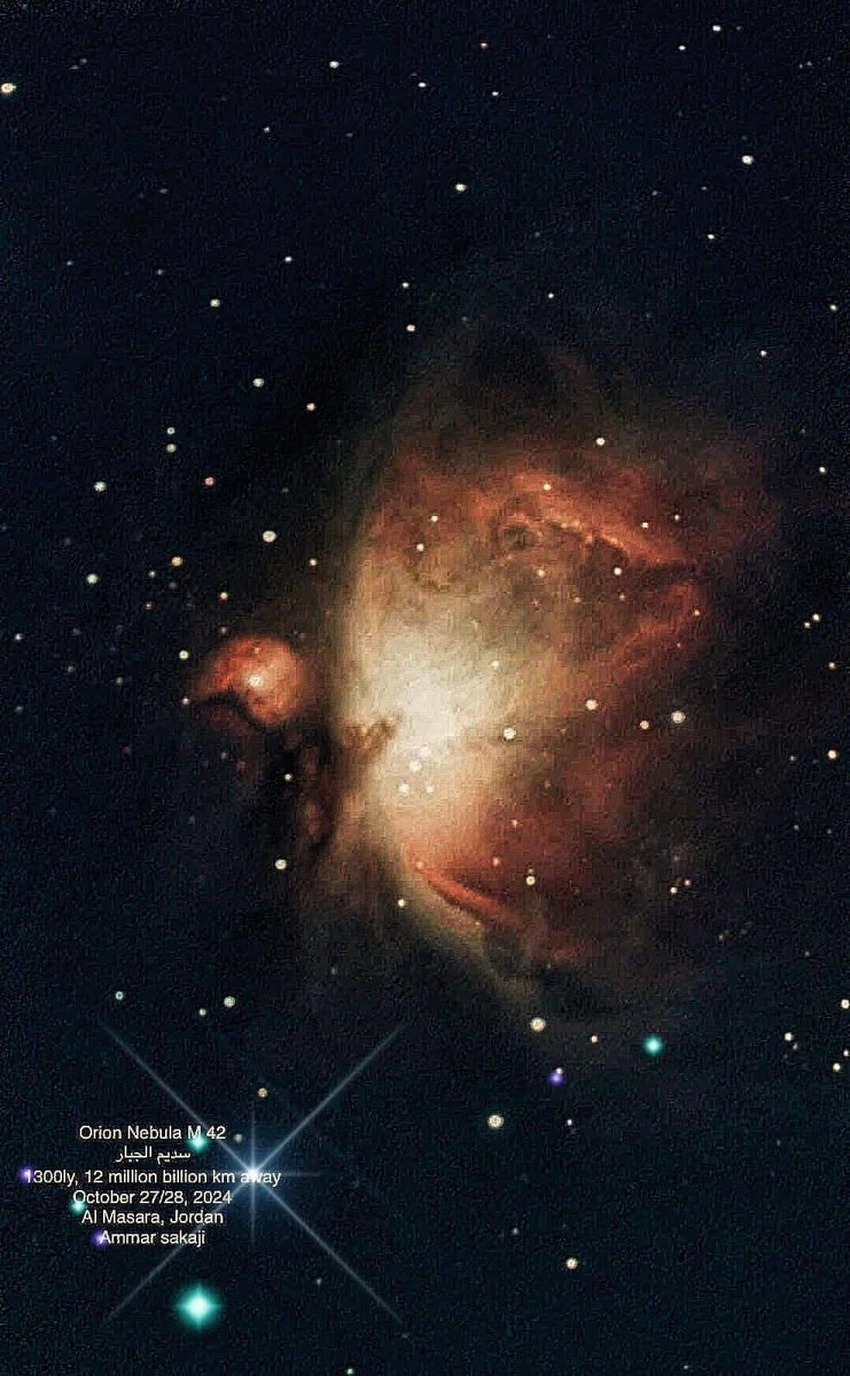Observing and photographing the `Orion Nebula` from the sky of Jordan
The Orion Nebula is one of the brightest nebulae in the sky, and can be seen with the naked eye in the night sky, especially on clear winter nights. It is considered a stellar incubator in many different cultures and belongs to the Milky Way galaxy. It is about 1,300 light years away from Earth, or about 12 million billion kilometers. It is the closest large region for star formation, and has astronomical importance, especially in studies and research related to the development and formation of stars. It is among the most intensively studied celestial features. The discovery of the Orion Nebula is attributed to the French astronomer Nicolas de Peiresc in 1610. In addition, it was observed by many astronomers, and Messier recorded it in his famous catalog in 1774 and classified it as M42.
In 1993, the Hubble Space Telescope (HST) first observed the Orion Nebula, providing iconic images of the nebula, as well as detailed 3D models. Since then, the nebula has been a frequent target of Hubble Space Telescope studies, most famously the image published by Hubble in 2005, which is considered one of the most detailed images of nebulae at the time. The James Webb Space Telescope (JWST) photographed the Orion Nebula in 2023 and found some wandering or errant planets (FFP) that do not belong to star systems and are as large as Jupiter. In addition to other images provided by James Webb, which contain amazing details, this star-forming cloud of gas and dust revealed new details about star formation. It may take many years to study and examine it, but the data is amazing and will serve as standards for astrophysical research for decades to come.

In addition to the spectral data of the Orion Nebula components provided by the James Webb Space Telescope, which provides a broader and deeper understanding of the physics of nebulae at the atomic level, as the spectral data set covers a smaller area of the sky compared to the images, but it contains a greater amount of information. If a picture is worth a thousand words, then a spectrum is worth a thousand pictures. The infrared images taken by the James Webb Space Telescope last May contain details and clarity of the inner region of the Orion Nebula, which is the closest massive star-forming region and the PDR.
At the center of the Orion Nebula are four massive, young stars arranged in a geometrical trapezoidal pattern. They were discovered by astronomer Galileo Galilei in 1617. According to recent computer simulations, the Orion Nebula cluster is believed to be home to a black hole with a mass more than 100 times that of the Sun. This black hole could theoretically be the closest to Earth. The Orion Nebula is part of a much larger nebula known as the Orion Molecular Cloud.
The Orion Nebula is located in the constellation Orion, which was known in ancient times to the Arabs as Gemini. It is one of the most famous constellations in human cultures and the most visible in the sky. Three very bright stars appear in the middle of the Orion constellation, called the “belt or band of Orion,” as shown in the image we captured. We photographed the nebula, which took hours to complete. The Arabs called it “the band, the system, and the region,” which is the same pronunciation in Arabic and English, because the origin of the name is Arabic. These three stars appear close to each other when seen from Earth, and are used in navigation, as the line connecting them extends to the stars Sirius and Aldebaran from the left and right. It appears that the five stars are in a straight line.
The Orion constellation includes many bright stars and celestial bodies, the most prominent of which are: Betelgeuse, Rigel, Orion's Belt, the Orion Nebula (pictured above), Mirzam, the Sword or Right Knee, the Sword's Light, and Al-Lisan or Al-Haq'ah, among other stars and nebulae. The Orion constellation region witnesses annual meteor showers, which are the remains of Halley's Comet. They are called the Orionid meteor showers because the center of the meteor radiation is visible in this constellation. The Orionid meteor shower peaks annually in October, at a rate of 20 meteors per hour.
The constellation of Gemini, which is the old name among the Arabs, included the current constellation of Orion in addition to parts of the current constellation of Gemini. The Arabs mentioned it in their heritage and books, as Abdul Rahman Al-Sufi mentioned it in his book Pictures of the Forty-Eight Planets, and it was under the names of Orion and Gemini.
The Orion constellation appears in the winter sky in Jordan these days in the eastern direction at approximately 10 pm, and rises in the sky to its maximum height at 3:45 am according to Jordanian time, heading west in an inverted manner, and remains in the sky throughout the winter nights, but at different sunrise and sunset times, and is clearly visible to the naked eye from the Jordanian sky and the northern hemisphere sky according to standard observational criteria.
To see the Orion Nebula in the Jordanian sky, you must first identify the Orion constellation, then look for the Orion Belt, which is three bright stars that form a straight line. Below the Orion Belt, you will see a nebulous cloud, which is the Orion Nebula. It can be seen in Jordan these days with the naked eye easily on winter days in the event of clear skies and standard observational criteria.
Browse on the official website